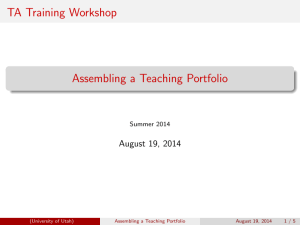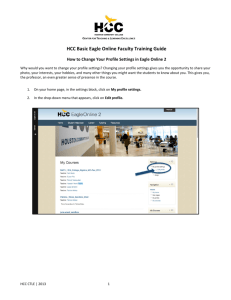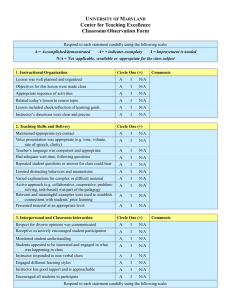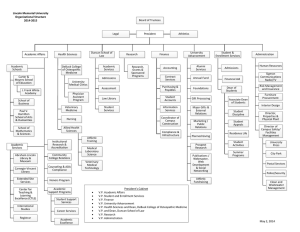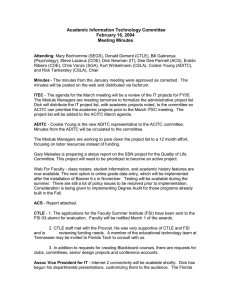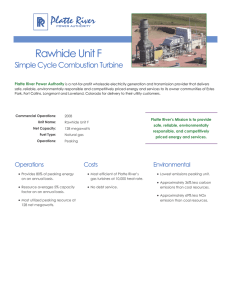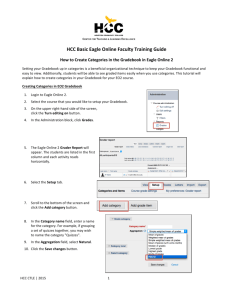Chip-to-module CAUI-4 CTLE peaking tolerancing
advertisement
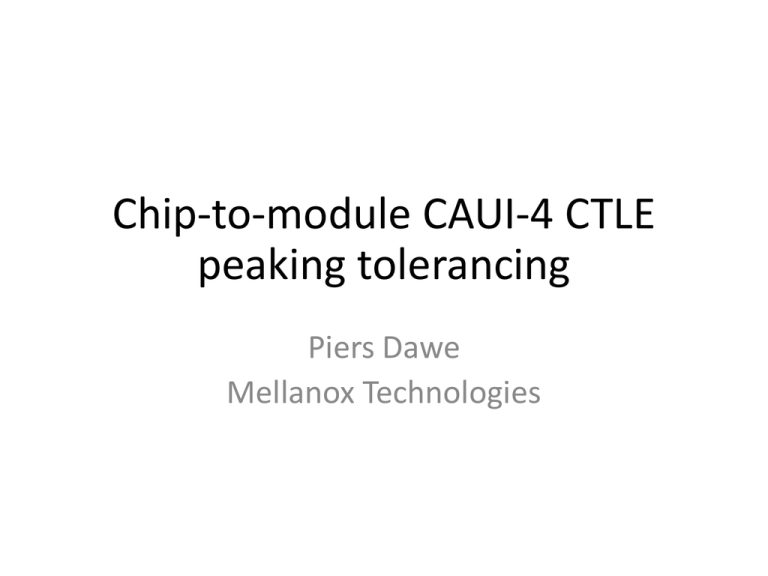
Chip-to-module CAUI-4 CTLE peaking tolerancing Piers Dawe Mellanox Technologies Problem statement • Comment 67 (at back of this slide pack): • The draft assumes that if the host provides an eye that's open within 1 dB of where the host says it's open, then it will be open where the module would use it. • It seems this is true if the host makes a reasonable recommendation, but the host could make an unhelpful recommendation and still be compliant • This presentation illustrates the problem and proposes a remedy IEEE P802.3bm, July 2014, San Diego Chip-to-module CAUI-4 CTLE peaking tolerancing 2 Simulations based on published channel model Example channel vs. OIF VSR insertion loss budget 0 Response (dB) -5 Chip-to-module CAUI-4 insertion loss budget -15 -20 -25 • • CEI-28G-VSR insertion loss budget -10 0 5 10 Frequency (GHz) 15 20 Based on oif2010_407 – there is an equivalent dataset in the 100GE channels page A little less loss than worst recommendation. No package model IEEE P802.3bm, July 2014, San Diego Chip-to-module CAUI-4 CTLE peaking tolerancing 3 Eye opening for maximum allowed Vpkpk Eye at 1e-15, 28 GBd 0.6 0.5 Dashed lines are spec limits 0.4 In this benign example, host could recommend any value from 1 to 9 0.3 0.2 0.1 0 1 2 3 -11 7 8 9 • -11.5 -12 dB(EH15) (dBV) 4 5 6 CTLE peaking (dB) -12.5 -13 This shape illustrates a rule of no more than 1 dB down, one step either way -13.5 -14 -14.5 -15 -15.5 1 2 3 4 5 6 7 CTLE peaking value (dB) IEEE P802.3bm, July 2014, San Diego 8 9 Change in EH15 for 1 dB change in CTLE setting (dB) Eye opening (UI bk, V bl, UI*V red) 0.7 All simulations are without emphasis, with Vpkpk at maximum 1.4 1.2 1 0.8 0.6 0.4 0.2 0 1 2 Chip-to-module CAUI-4 CTLE peaking tolerancing 3 4 5 6 7 CTLE peaking value (dB) 8 9 4 Eye at 1e-15, 28 GBd Slower... 0.6 0.5 0.4 0.3 0.2 0.1 0 1 2 3 -12 7 8 9 • -12.5 dB(EH15) (dBV) 4 5 6 CTLE peaking (dB) -13 -13.5 -14 -14.5 -15 -15.5 -16 -16.5 1 2 3 4 5 6 7 CTLE peaking value (dB) IEEE P802.3bm, July 2014, San Diego 8 9 Change in EH15 for 1 dB change in CTLE setting (dB) Eye opening (UI bk, V bl, UI*V red) 0.7 1.6 1.4 1.2 1 0.8 0.6 0.4 0.2 0 1 2 Chip-to-module CAUI-4 CTLE peaking tolerancing 3 4 5 6 7 CTLE peaking value (dB) 8 9 5 Slower... Eye at 1e-15, 28 GBd EW limit 0.6 • 0.5 • 0.4 0.3 0.2 0.1 0 1 2 3 -14 4 5 6 CTLE peaking (dB) 7 8 9 dB(EH15) (dBV) -16 -18 -20 -22 -24 -26 1 2 3 4 5 6 7 CTLE peaking value (dB) IEEE P802.3bm, July 2014, San Diego 8 9 Change in EH15 for 1 dB change in CTLE setting (dB) Eye opening (UI bk, V bl, UI*V red) 0.7 Host could report 2 and be compliant (because eye meets spec at 3) Compliant module might work at 2 (3 dB less Eye Height than at 3, and failing Eye Width) but might not at 1, where the height is 8 dB less than at 3, and falling off at 4 dB/step, and Eye Width is very poor 4.5 4 3.5 3 2.5 2 1.5 1 0.5 0 1 2 Chip-to-module CAUI-4 CTLE peaking tolerancing 3 4 5 6 7 CTLE peaking value (dB) 8 9 6 Eye at 1e-15, 28 GBd Even slower EW limit 0.6 • 0.5 0.4 Proposed 80 mV secondary limit 0.3 0.2 • 0.1 0 1 2 3 -18 4 5 6 CTLE peaking (dB) 7 8 9 dB(EH15) (dBV) -20 -22 -24 -26 -28 -30 -32 -34 -36 1 2 3 4 5 6 7 CTLE peaking value (dB) IEEE P802.3bm, July 2014, San Diego 8 9 Change in EH15 for 1 dB change in CTLE setting (dB) Eye opening (UI bk, V bl, UI*V red) 0.7 Host could report 4 and be compliant (because eye meets spec at 5) Compliant module set at 3, gets 3 dB less height than at 4, and falling off at 6 dB/step, and Eye Width is very poor 12 10 8 6 4 2 0 1 2 Chip-to-module CAUI-4 CTLE peaking tolerancing 3 4 5 6 7 CTLE peaking value (dB) 8 9 7 Second-guessing the spec • The module maker could observe that the rolloff is steeper on the low side and set up higher than the recommended value • Or the host maker could observe the same thing, and recommend higher than actual • If they both think of it, they will double compensate, and between them get a bad result, and/or go beyond 9 dB IEEE P802.3bm, July 2014, San Diego Chip-to-module CAUI-4 CTLE peaking tolerancing 8 Discussion • An EH15 minimum that's 1 dB less than the current one, to be applied at +/-1 dB from recommended CTLE peaking value, seems to help • Comment proposes 80 mV (1.5 dB less than the 95 mV primary EH15 limit) at recommendation +/- 1 dB • A simpler option might be to require 90 mV at the recommendation, if someone else wants to do the analysis to show that it fixes the problem IEEE P802.3bm, July 2014, San Diego Chip-to-module CAUI-4 CTLE peaking tolerancing 9 Comment 67 83E.3.1 page 166 line 22 According to 83E.3.1.6, the host provides a recommended CTLE peaking value. According to 83E.4.2, the host's eye must pass the spec at this value or 1 dB higher or lower if within the range 1 to 9. However, simulation shows that if the host gives a compliant but unhelpful recommendation, EH15 can be up to 8 dB smaller than the limit in Table 83E-1 within 1 dB of the recommendation (this is allowing 1 dB for the module). We could impose some accuracy spec on the recommendation, but it is more useful and easier for the host to simply require that the eye is open at and around the setting the host recommends, by adding a subsidiary eye height spec. This 80 mV spec is chosen so that a host which gives a reasonable recommendation is not inconvenienced, and the host can trade off accuracy and eye opening - but the module is protected from a very unhelpful recommendation. A simpler option might be to require 90 mV at the recommendation, if someone else wants to do the analysis to show that it fixes the problem. This would reduce the number of host tests but is less generous to hosts that give realistic recommendations and may protect the module less well. The text in 83E.4.2 would benefit from a little wordsmithing anyway. Insert a second limit below the 95 mV, of 80 mV (1.5 dB lower than 95 mV). In 83E.4.2, change: For host compliance, the CTLE peaking in the reference receiver shall be set to one of three values. These are: a) the recommended CTLE peaking value provided by the host, b) the value 1 dB higher if present in Table 83E-2, c) the value 1 dB lower if present in Table 83E-2. Any of the three CTLE settings that meets both eye width and eye height defined in Table 83E-1 is acceptable. to For host compliance, the CTLE peaking in the reference receiver shall be set to three values. These are: a) the recommended CTLE peaking value provided by the host, b) the value 1 dB higher if present in Table 83E-2, c) the value 1 dB lower if present in Table 83E-2. A compliant host passes both the eye width and the larger eye height limit specified in Table 83E-1 at at least one of the settings, and passes the smaller eye height limit specified in Table 83E-1 at all of the two or three settings. IEEE P802.3bm, July 2014, Chip-to-module CAUI-4 CTLE peaking 10 San Diego tolerancing

